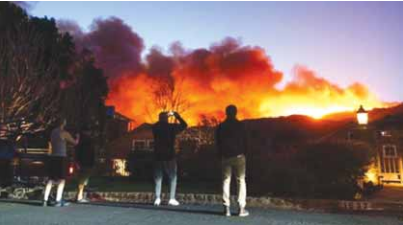January 2025: Uncontrolled wildfires ravaged parts of Los Angeles, destroying hundreds of buildings, causing at least ten fatalities, and forcing around 180,000 residents to evacuate. The fires were fueled by strong winds and prolonged drought conditions.
Los Angeles and San Diego County, California
A series of 14 catastrophic wildfires engulfed the Los Angeles metropolitan area and San Diego County from January 7 to 31, 2025, fueled by drought conditions, low humidity, and powerful Santa Ana winds. With wind gusts reaching up to 100 miles per hour (160 km/h), the fires led to widespread destruction, claiming at least 29 lives, displacing over 200,000 residents, and consuming more than 18,000 homes and structures. In total, the wildfires burned approximately 57,000 acres (23,000 ha; 89 sq mi) of land.
Major Fires and Emergency Response
Among the most devastating fires were the Eaton Fire in Altadena and the Palisades Fire in Pacific Palisades. These two blazes, fully contained by January 31, ranked as the second and third-most destructive fires in California’s history. Firefighting efforts were led by municipal fire departments and the California Department of Forestry and Fire Protection (CAL FIRE), with both ground teams and tactical aircraft deployed to combat the flames.
Forecasted Disaster and Climatic
Conditions
The National Interagency Fire Center (NIFC) had warned of “above normal significant fire potential” as early as January 2. By January 7, the Storm Prediction Center (SPC) had issued an extreme fire weather warning for Southern California, marking multiple days of critical fire risk. As the fires spread, the National Weather Service (NWS) declared a red flag warning for Los Angeles and Ventura counties, citing dangerously dry conditions exacerbated by a transition from El Niño to La Niña, which left the region in a moderate drought by late December 2024.
Climate Change and Fire
Intensification
Scientific analyses from the Institut Pierre Simon Laplace and Climate Central indicated that anthropogenic climate change had intensified the fire conditions, contributing to increased temperatures, erratic rainfall, and prolonged dry seasons. Researchers found that rising urban temperatures and decreased precipitation heightened wildfire risks, while shifts in seasonal weather patterns extended the fire season further into the months dominated by Santa Ana winds.
Unprecedented Wind Conditions
The Santa Ana winds that fueled the fires reached exceptional speeds, with gusts recorded at 100 mph (160 km/h) on Mount Lukens and 98 mph (158 km/h) in the Santa Monica Mountains. The NWS described the windstorm as potentially “life-threatening,” with widespread power outages and downed trees reported across the region. By January 7, reports from Magic Mountain Truck Trail in Santa Clarita confirmed wind speeds of 84 mph (135 km/h), leading the NWS to compare the event to the region’s most destructive windstorm since 2011.
Compounding Human Factors
Budgetary Constraints on Firefighting Efforts
The Los Angeles Fire Department (LAFD) faced operational challenges due to a $17.6 million budget reduction for the 2024–2025 fiscal year. Fire Chief Kristin Crowley noted that these cuts severely impacted emergency response preparedness and brush clearance inspections. Additionally, rising costs and delays in acquiring new fire trucks hindered fire departments across the United States.
Aging Infrastructure and Construction Codes
Older neighbourhoods, particularly in the Palisades, suffered extensive damage due to outdated building codes. Many homes, built in the 1950s and 1960s, lacked modern fire-resistant materials, making them more susceptible to ignition.
Electric Grid Vulnerabilities
Los Angeles’ power grid was ill-equipped to handle the extreme wind conditions, with infrastructure designed to withstand only up to 56 mph (90 km/h) winds. Experts criticized the Los Angeles Department of Water and Power (LADWP) for not implementing proactive power shut-offs to prevent electrical fires.
Homelessness and Fire Incidents
A growing number of fires in Los Angeles were linked to homelessness. By 2024, an average of 46 homeless-related fires occurred daily, worsening an already precarious fire safety situation.
Water Supply Shortages
Firefighters faced critical water shortages as storage tanks in high-elevation neighborhoods were depleted faster than they could be refilled. The Santa Ynez Reservoir, a crucial water source for Pacific Palisades, had been emptied for maintenance, significantly reducing available water pressure during the emergency.
Preparation and Government Response
Governor Gavin Newsom mobilized 65 fire engines, seven helicopters, and over 100 personnel in response to the growing crisis. The Mayor of Los Angeles, Karen Bass, issued warnings to residents and coordinated emergency operations. However, as she was attending the inauguration of Ghanaian President John Mahama, acting mayor Marqueece Harris-Dawson oversaw local efforts. Utility providers, including Southern California Edison and San Diego Gas & Electric, preemptively cut power in high-risk areas to mitigate potential ignitions.
Lead-up and Early Impact
On January 7, Los Angeles declared a state of emergency. The South Coast Air Quality Management District (AQMD) issued dust storm warnings, while power outages left over 20,000 customers in the dark. The National Weather Service called the event the strongest windstorm of 2025, while the Federal Aviation Administration issued temporary flight restrictions due to hazardous conditions.
Conclusion
The January 2025 wildfires stand as one of the most severe climate disasters in recent California history. The combination of extreme wind, prolonged drought, and inadequate infrastructure response underscores the urgent need for climate-adaptive policies, improved fire management funding, and enhanced urban planning to mitigate future wildfire disasters.
Source:
www.wri.org






